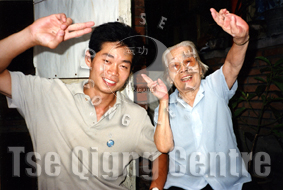Qigong is a Chinese health exercise made up of gentle movements that connect with the acupuncture points and meridians of our body. The word Qigong literally means “energy work”. Using relaxation and breathing along with these special movements, we have Qigong.
Qigong will help you to relax and become more aware of your body. As we practise more, we will begin to notice changes in our body including more flexibility, energy and stamina. This is because the Qi is working to heal any old illnesses or injuries and to open the channels so that the Qi can flow naturally, making us feel younger and more alive. There are many types and styles of Qigong, but the style which you will learn is called the Kunlun Dayan – Wild Goose Qigong system.
There are several forms in the Kunlun Dayan Qigong system, not only just Wild Goose Qigong, and each form has its own special emphasis. For instance, Dayan (Wild Goose) Qigong is good for overall health and flexibility of the body. Balancing Gong is good for beginners, helping them to learn the right posture and relaxation. Jade Pillar Gong is good for the spine and Dayan Palm is a very vigorous form which combines soft, gentle movements with jumping and kicking to make the body stronger and lighter. Also included in the system are several meditation and healing methods which are used for cultivating the body and mind. In the past, there were 72 forms and methods in the system and, today, just over half of these have survived.


Nearly two thousand years ago during the Jin Dynasty (265-420AD), Kunlun Shan, which is a mountain range near Tibet, was home to many Daoists. The monks living there would spend their days studying Daoist teachings, hoping to eventually receive enlightenment and immortality. Kunlun Shan was also home to many wild geese called Da Yan (Big Wild Goose). They were not normal geese as these geese, believed to be the Bar Headed Goose, live twice as long and fly higher than any other geese in the world. The Da Yan became a longevity symbol to the monks who observed these special birds closely. They began to imitate their movements and combine this with Chinese medicine knowledge, eventually forming sets of health exercises known as Dayan Qigong.
The Jin Dynasty saw the rapid expansion of both Buddhism and Daoism. One Buddhist monk named Dao An was the translator of many Buddhist texts and connected with the Pure Land (Amitabha) Buddhism particularly. This type of Buddhism concentrated only on chanting the name of Amitabha Buddha so that they might be reborn in his Western Pure Land. The idea of letting go of the mind and body so that enlightenment will happen naturally follows the principles of the Kunlun Dayan Qigong skill. Hence, Dao An was considered the spiritual founder of the skill.
It is because of this special lady that all of us have the opportunity to learn the Kunlun Dayan Qigong. When she was 13 years old, her grandfather began to teach her secretly, making her promise not to teach anyone until she was 70 years old as this was the promise he had made to the Daoist monk who had taught him.
Although she was only supposed to pass on the skill to one other person, she had survived the Japan War and Cultural Revolution where many others did not. She did not want to see the skill lost so she decided to slowly open the skill to public after the finish of the Cultural Revolution.
Master Michael Tse is one of the few people who was accepted as a close student by Grandmaster Yang Meijun and given permission by her to teach her skill. It is due to Master Tse’s efforts over the past two decades that Wild Goose Qigong and Qigong as a whole are now widely known in the west.


When you come to class, you will see people at many different levels, some beginners, some seniors as everyone learns individually following a syllabus from beginning, foundation movements to more advanced.
Balancing Gong
These movements form the basis of our learning, helping us to find the right posture, breathing and relaxation. Balancing Gong is good for circulation, flexibility and balance as well as helping arthritis, backache, joint problems and coordination. These movements are based upon the principles of the Dayan Qigong and were created by Master Tse to help beginners.
Healthy Living Gong Parts I, II, III
Healthy Living Gong is a set of exercises also created by Master Michael Tse, based upon all his years of Qigong and martial art experience. Each of the three sets of movements strengthen the body and increase vital energy, which we call Qi. Part I focuses on relaxation, Part II works on improving fitness and coordination and Part III cultivates power and physical strength.
Wild Goose (Dayan) Qigong
Unlike the previous stand alone movements, Wild Goose Qigong is a series of connected movements which make up a form. There are two parts, the first 64 movements and the second 64 movements. The 1st 64 form works on post natal illnesses and can clear up old injuries as well. The 2nd 64 form works on prenatal illnesses, or weaknesses in the body with which we were born. In these forms, there are a variety of fluttering, shaking and jerking movements which rid the body of toxins.
Meditation
We need meditation to balance movement as movement is Yang and meditation is Yin. When we practise forms, we open our acupuncture points and channels, clearing blockages and releasing the negative Qi. This means our Qi can flow smoothly. Meditation allows us to gather and store the fresh Qi that we have gathered during our practice. As we reach higher levels, then meditation also helps to develop our wisdom and our Sky Eye potential so that we can sense more
© Copyright Norwich Qigong and Kung Fu